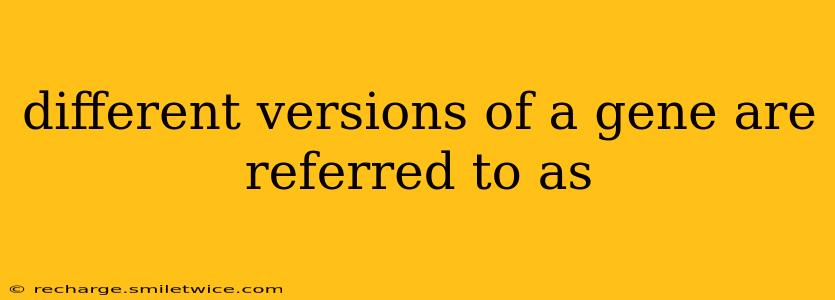Different versions of a gene are called alleles. Understanding alleles is fundamental to grasping the basics of genetics and inheritance. This article will delve into what alleles are, how they work, and their significance in shaping traits.
What are Alleles?
An allele is one of two or more versions of a gene. Genes are segments of DNA that code for specific traits, such as eye color or blood type. Since we inherit one copy of each gene from each parent, we possess two alleles for every gene – one from our mother and one from our father. These alleles can be identical (homozygous) or different (heterozygous).
How do Alleles Determine Traits?
The interaction between these two alleles determines which trait is expressed. Some alleles are dominant, meaning they mask the effect of the other allele (the recessive allele). A recessive allele will only be expressed if both alleles are recessive. For example, if "B" represents the dominant allele for brown eyes and "b" represents the recessive allele for blue eyes, someone with the genotype "BB" (homozygous dominant) or "Bb" (heterozygous) will have brown eyes. Only someone with the genotype "bb" (homozygous recessive) will have blue eyes.
What is the Difference Between a Gene and an Allele?
It's important to distinguish between a gene and an allele. A gene is the basic unit of heredity, a specific sequence of DNA that codes for a particular trait. An allele, on the other hand, is a specific variant of that gene. Think of it like this: the gene is the blueprint for a house (e.g., the gene for eye color), while the alleles are the different possible designs for that house (e.g., blue eyes, brown eyes, green eyes).
Can Alleles be More Than Just Dominant and Recessive?
While the dominant/recessive model is a simplified explanation, allele interactions can be more complex. Some alleles show incomplete dominance, where the heterozygous genotype results in a phenotype that is a blend of the two homozygous phenotypes. For instance, a red flower (RR) crossed with a white flower (WW) might produce pink flowers (RW). Other alleles demonstrate codominance, where both alleles are expressed equally in the heterozygous phenotype. An example of this is the AB blood type, where both A and B antigens are present.
What are Some Examples of Alleles?
Numerous examples illustrate the concept of alleles. Consider:
- Eye color: Different alleles determine the various shades of eye color.
- Hair color: Alleles control the production of melanin, determining hair color.
- Blood type: The ABO blood group system is determined by three alleles (IA, IB, and i).
- Height: Height is a polygenic trait, influenced by multiple genes, each with different alleles.
- Disease susceptibility: Some alleles increase the risk of developing certain diseases.
How Many Alleles Can a Gene Have?
A gene can have more than two alleles, although an individual can only possess two (one from each parent). The ABO blood group system is a good example, with three alleles determining blood type. However, many genes only have two common alleles within a population.
Understanding alleles is crucial for understanding how traits are inherited and how genetic variation arises. This knowledge forms the basis of numerous fields, including medicine, agriculture, and evolutionary biology.
